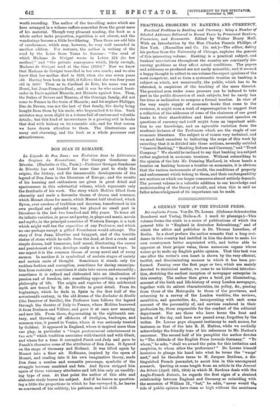CASTLES AND CHATEAUX OF OLD TOURAINE.
Castles and Châteaux of Old Touraine and the Loire Country. By Francis Miltoun. With many Illustrations by Blanche McManus. (Sir Isaac Pitman and Sons. 7s. 6d. net.)—This is a pretty and attractive but rather confusing book. One cannot say, of course, that the subject of Touraine and its attributes is exhausted, for it is inexhaustible. Nowhere do we find more romantic history, more enchanting architecture, or a nature more rich as to climate, products, and peaceful beauty. There is no reason why the pilgrimages of writers and artists should cease. Every one's impressions are in some way different, and most are
worth recording. The author of the travelling notes which are here arranged in a volume suffers somewhat from the great mass of his material. Though very pleasant reading, the book as a whole rather lacks proportion, repetition is not absent, and the wanderings become a little bewildering. Then there are odd bits of carelessness, which may, however, be very well amended in another edition. For instance, the author is writing of the road by the Loire from Tours to Saumur : "the road of which Madame de Sevigne wrote in Lettre 224 (to her mother)" and "the private conveyance which, likely enough, Madame de Sevigne used at the time (1630)." Now we know that Madame de Sevigne travelled in her own coach ; and we also know that her mother died in 1633, when she was seven years old. Having been born in 1626, it follows that she was four years old in 1630! Then as to Cardinal de Rots, his name was not Henri, but Jean-Francois-Paul; and it was he who raised barri- cades in Paris against Mazarin, not Mazarin against him. Then, the Dukes of Nevers and Mantua, of the Gonzaga family, did not come to France in the train of Mazarin ; and his nephew Philippe, Due de Nevers, was not the last of that family, the duchy being bought from them by his uncle, who bequeathed it to him. Such mistakes may seem slight in a volume full of curious and valuable details; but this kind of incorrectness is a growing evil in books that deal with history on its romantic side, and for that reason we have drawn attention to them. The illustrations are many and charming, and the book as a whole possesses real attractiveness.































































 Previous page
Previous page